1998 CADILLAC ELDORADO roof
[x] Cancel search: roofPage 15 of 380
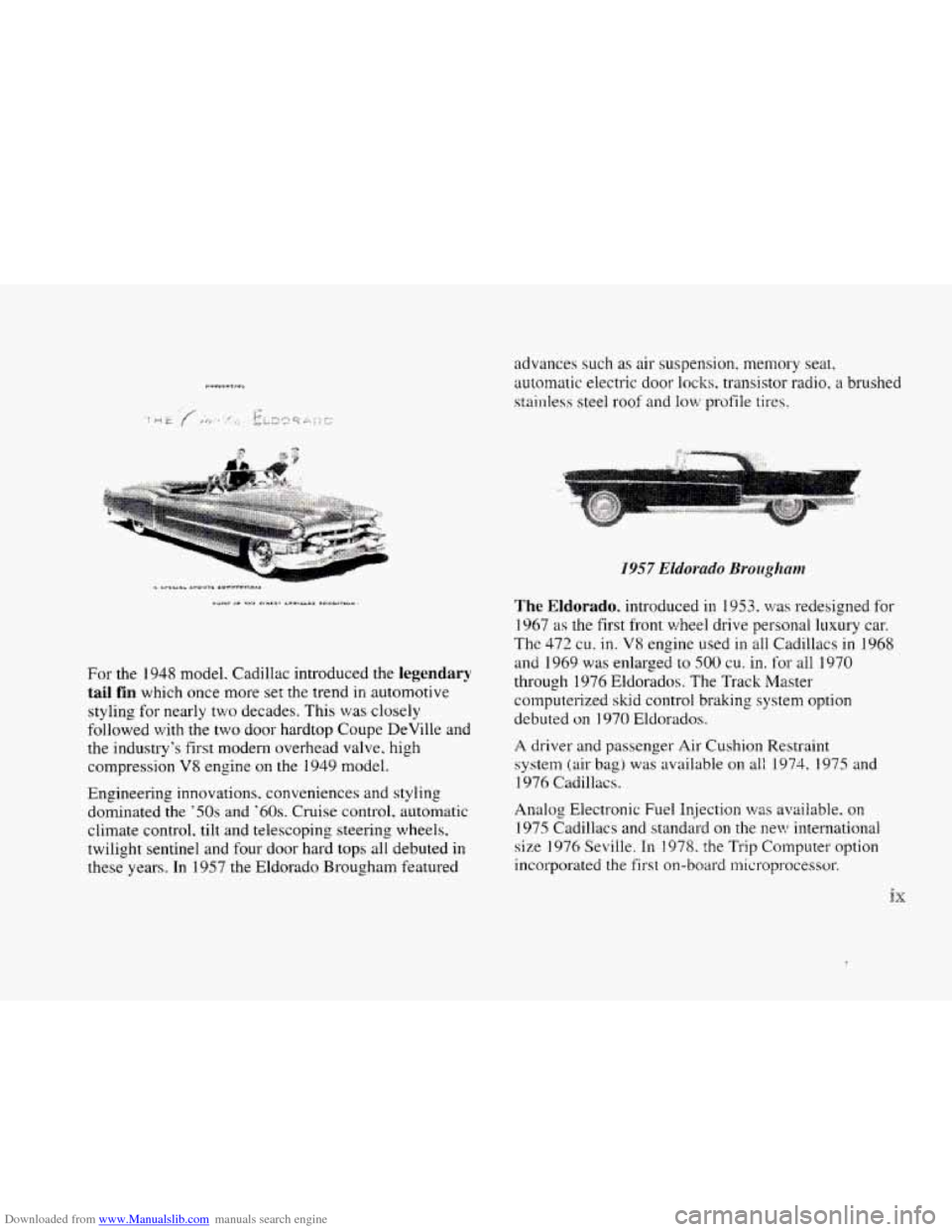
Downloaded from www.Manualslib.com manuals search engine For the 1948 model. Cadillac introduced the legendary
tail fin
which once more set the trend in automotive
styling
for nearly two decades. This was closely
followed with the two door hardtop Coupe DeVille and
the industry’s first modem overhead valve, high
compression
V8 engine on the 1949 model.
Engineering innovations. conveniences and styling
dominated
the ’50s and ‘60s. Cruise control, automatic
climate control.
tilt and telescoping steering wheels,
twilight sentinel and four door hard tops
all debuted in
these years. In 1957 the Eldorado Brougham featured advances
such as air suspension. memory seat,
automatic electric
door locks, transistor radio. a brushed
stainless steel roof and
low profile tires.
The Eldorado. introduced in 1953, wziS redesigned for
1967 as the first front wheel drive personal luxury car.
The
472 cu. in. V8.engine used in all Cadiilacs in 1968
and 1969 was enlarged to SO0 cu. in. for all 1970
through 1976 Eldorados. The
Track Master
computerized
skid control braking system option
debuted on
1970 Eldorados.
A driver and passenger Air Cushion Restraint
system (air bag) was available on
ali 1974. 1975 and
1976 Cadillacs.
Analog Electronic Fuel Injection
was available. on
1975 Cadillacs and standard on the new international
size 1976 Seville. In
1978. the Trip Computet. option
incorporated the first on-board microprocessor.
Page 71 of 380

Downloaded from www.Manualslib.com manuals search engine Section 2 Features and Controls
Here you can learn about the many standard and optional features on your vehicle, and information on starting,
shifting and braking. Also explained are the instrument panel and the warning systems that tell you
if everything is
working properly
-- and what to do if you have a problem.
2-2
2-4
2-6
2-9
2- 13
2- 14
2-16
2- 17
2- 17
2-19
2-20
2-2
1
2-25
2-26
2-28
2-29 Keys
Door Locks
Remote Keyless Entry
(RKEj System
Trunk
Theft
Theft-Deterrent System (If Equipped)
PASS-Key(%
New Vehicle “Break-In”
Ignition Positions
Starting Your Engine
Engine Coolant Heater (If Equipped)
Automatic Transaxle Operation
Parking Brake
Shifting Into PARK (P)
Shifting Out of PARK (P)
Parking Over Things That
Burn
2-29
2-30
2-3 1
2-32
2-32
2-39
2-42
2-44
2-49
2-5
1
2-5 1
2-52
2-52
2-56
2-6
1
2-70
Engine Exhaust
Running
Your Engine While You‘re Parked
Windows
Tilt Wheel
Turn SignalMultifunction Lever
Exterior Lamps
Interior Lamps
Mirrors
Storage Compartments
Sun Visors
Cellular Telephone (Option)
Astroroof (Option)
Universal Transmitter (Option
j
Instrument Panel
Warning Lights, Gages and Indicators
Driver Information Center (DIC)
2-1
Page 88 of 380
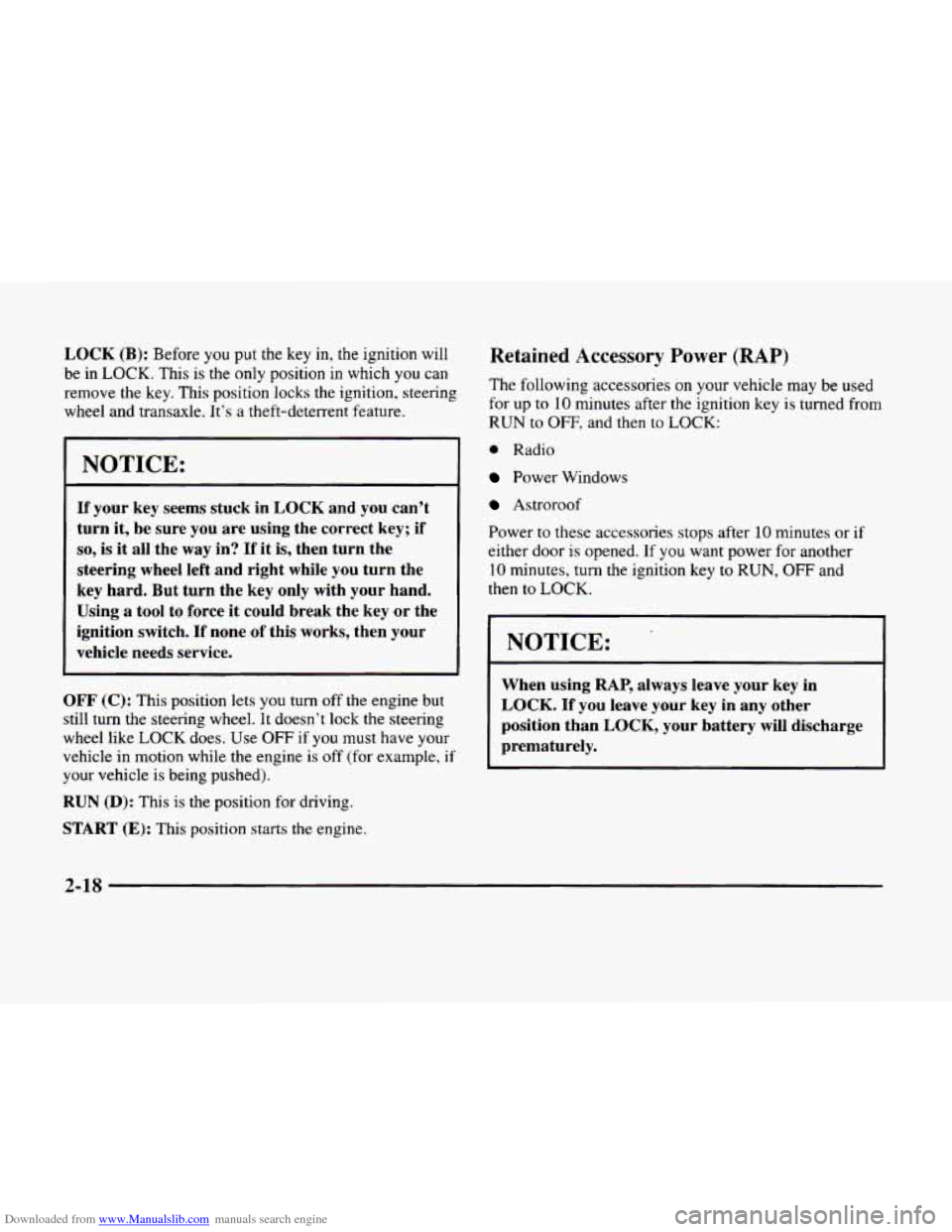
Downloaded from www.Manualslib.com manuals search engine LOCK (B): Before you put the key in, the ignition will
be in LOCK. This
is the only position in which you can
remove the key. This position
locks the ignition, steering
wheel and transaxle. It’s a theft-deterrent feature.
NOTICE:
If your key seems stuck in LOCK and you can’t
turn it,
be sure you are using the correct key; if
so, is it all the way in? If it is, then turn the
steering wheel left and right while you turn the
key hard. But turn the key only with your hand.
Using
a tool to force it could break the key or the
ignition switch.
If none of this works, then your
vehicle needs service.
OFF (C): This position lets you turn off the engine but
still turn the steering wheel. It doesn’t lock the steering
wheel like LOCK does. Use
OFF if you must have your
vehicle in motion while the engine
is off (for example, if
your vehicle is being pushed).
RUN (D): This is the position for driving.
START (E): This position starts the engine.
Retained Accessory Power (RAP)
The following accessories on your vehicle may be used
for up
to 10 minutes after the ignition key is turned from
RUN to OFF, and then to LOCK:
0 Radio
Power Windows
Astroroof
Power to these accessories stops after
10 minutes or if
either door is opened. If you want power for another
10 minutes, turn the ignition key to RUN, OFF and
then
to LOCK.
NOTICE:
When using RAP, always leave your key in
LOCK. If you leave your key in any other
position than
LOCK, your battery will discharge
prematurely.
2-18
Page 113 of 380
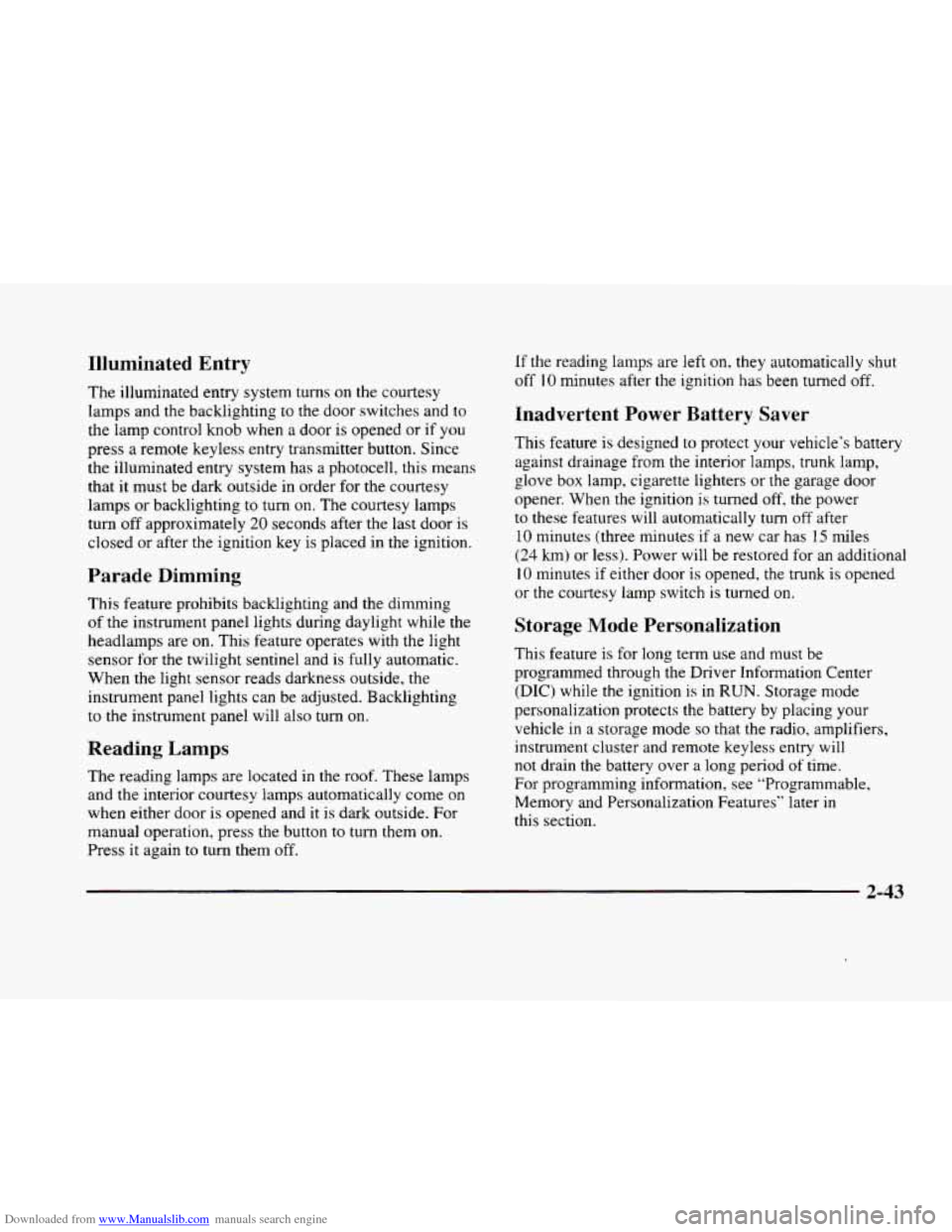
Downloaded from www.Manualslib.com manuals search engine Illuminated Entry
The illuminated entry system turns on the courtesy
lamps and the backlighting to the door switches and to
the lamp control knob when a door is opened or
if you
press a remote keyless entry transmitter button. Since
the illuminated
entry system has a photocell, this means
that it must be dark outside in order for the courtesy
lamps or backlighting
to turn on. The courtesy lamps
turn off approximately
20 seconds after the last door is
closed
or after the ignition key is placed in the ignition.
Parade Dimming
This feature prohibits backlighting and the dimming
of the instrument panel lights during daylight while the
headlamps are
on. This feature operates with the light
sensor for the twilight sentinel and is fully automatic.
When
the light sensor reads darkness outside, the
instrument panel lights can be adjusted. Backlighting
to the instrument panel will also turn on.
Reading Lamps
The reading lamps are located in the roof. These lamps
and the interior courtesy lamps automatically come on
when either door
is opened and it is dark outside. For
manual operation, press the button
to turn them on.
Press it again to turn them off. If
the reading lamps are left
on. rney automatically shut
off IO minutes after the ignition has been turned off.
Inadvertent Power Battery Saver
This feature is designed to protect your vehicle’s battery
against drainage from the interior lamps, trunk lamp,
glove box lamp, cigarette lighters or the garage door
opener. When
the ignition is turned off, the power
to these features will automatically turn off after
10 minutes (three minutes
if a new car has I5 miles
(24 km) or less). Power will be restored for an additional
10 minutes if either door is opened, the trunk is opened
or the courtesy lamp switch is turned on.
Storage Mode Personalization
This feature is for long term use and must be
programmed through the Driver Information Center
(DIC) while the ignition is in RUN. Storage mode
personalization protects the battery by placing your
vehicle in a storage mode
so that the radio, amplifiers,
instrument cluster and remote keyless entry will
not drain the battery over a long period of time.
For programming information, see “Programmable,
Memory and Personalization Features” later
in
this section.
2-43
Page 119 of 380
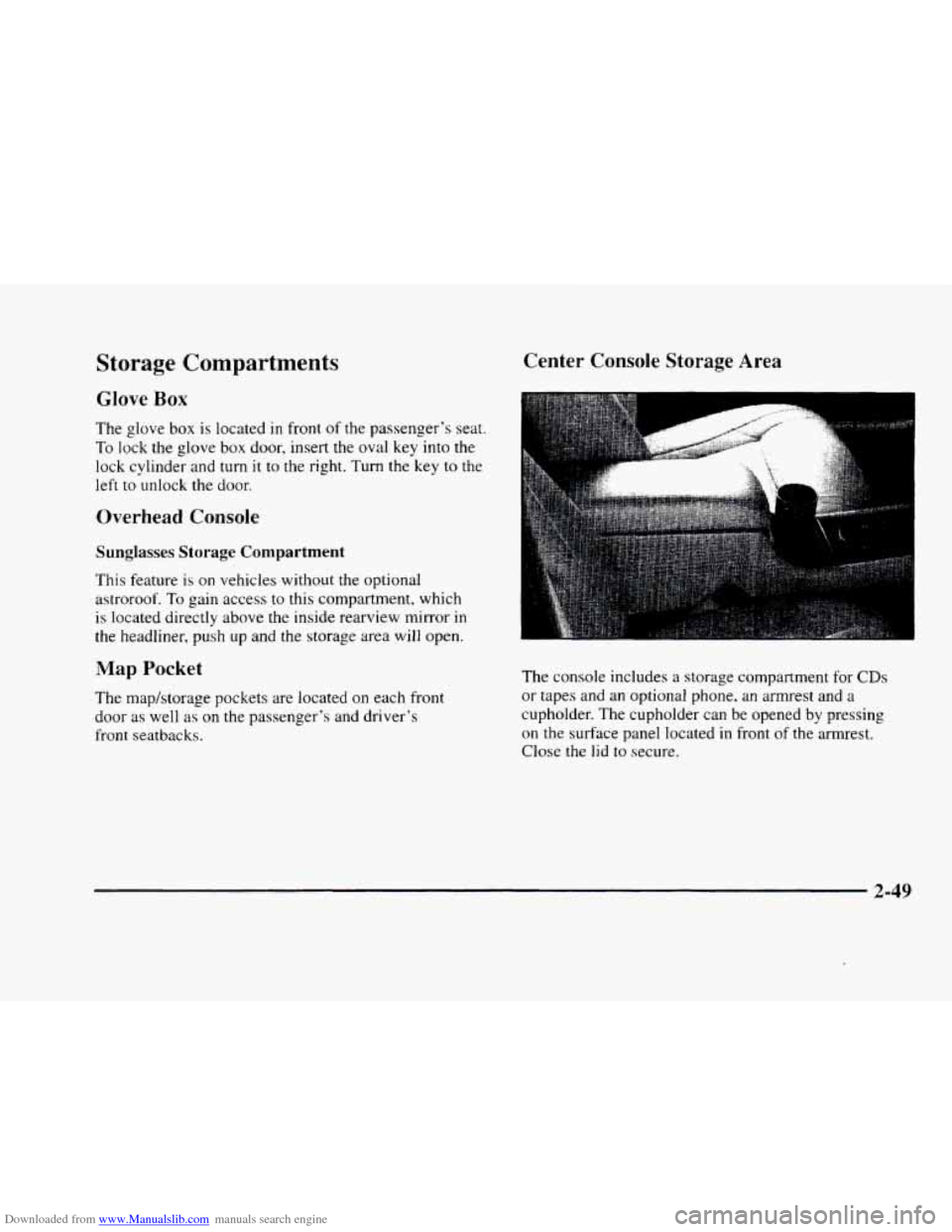
Downloaded from www.Manualslib.com manuals search engine Storage Compartments
Glove Box
The glove box is located in front of the passenger’s seat.
To lock the glove box door, insert the oval key into the
lock cylinder and
turn it to the right. Turn the key to the
left to unlock the door.
Overhead Console
Sunglasses Storage Compartment
This feature is on vehicles without the optional
astroroof.
To gain access to this compartment, which
is located directly above the inside rearview mirror in
the headliner, push
up and the storage area will open.
Map Pocket
The map/storage pockets are located on each front
door
as well as on the passenger’s and driver’s
front seatbacks.
Center Console Storage Area
The console includes a storage compartment for CDs
or tapes and an optional phone, an armrest and a
cupholder. The cupholder can be opened by pressing
on the surface panel located in front of the armrest.
Close
the lid to secure.
2-49
Page 122 of 380
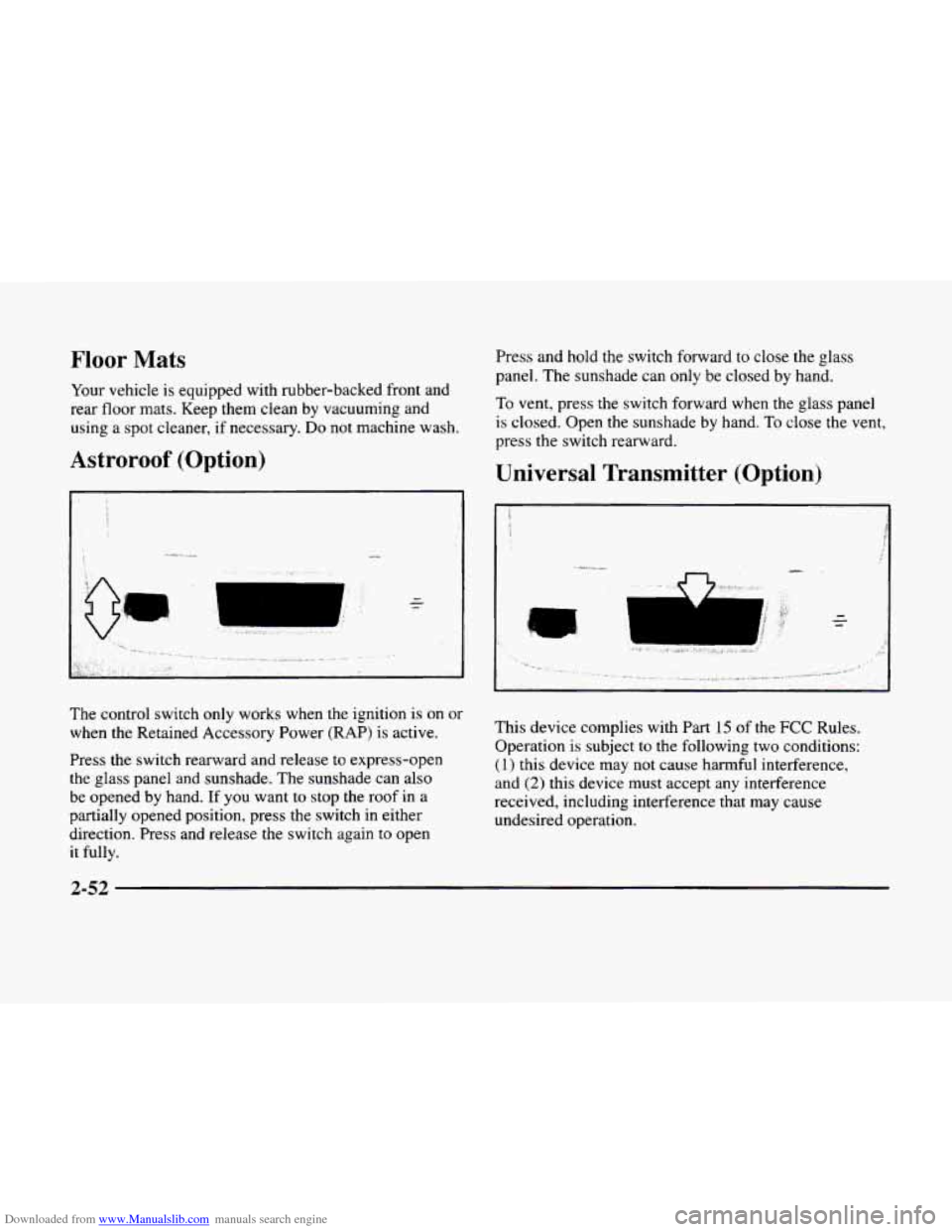
Downloaded from www.Manualslib.com manuals search engine Floor Mats
Your vehicle is equipped with rubber-backed front and
rear floor mats. Keep them clean by vacuuming and
using a spot cleaner, if necessary.
Do not machine wash.
Astroroof (Option)
Press and hold the switch forward to close the glass
panel.
The sunshade can only be closed by hand.
To vent, press the switch forward when the glass panel
is closed. Open the sunshade by hand. To close the vent,
press the switch rearward.
Universal Transmitter (Option)
I
The control switch only works when the ignition is on or
when the Retained Accessory Power (RAP) is active.
Press the switch rearward and release to express-open
the glass panel and sunshade. The sunshade can also
be opened by hand. If
you want to stop the roof in a
partially opened position, press
the switch in either
direction. Press and release
the switch again to open
it
fully.
This device complies with Part 15 of the FCC Rules.
Operation is subject
to the following two conditions:
(1) this device may not cause harmful interference,
and
(2) this device must accept any interference
received, including interference that
may cause
undesired operation.
2-52
Page 363 of 380

Downloaded from www.Manualslib.com manuals search engine ........
Section 8 Index
ABS ......................................... 4-7
Adding Equipment to the Outside
of Your Vehicle ...... 6-3
AirBag
....................................... 1-20
How Does it Restrain
.......................... 1-24
How it Works
................................ 1-22
Location
.................................... 1-22
Readiness Light
......................... 1-21. 2-61
Servicing
................................... 1-25
What Makes it Inflate
.......................... 1-23
What Will You See After it Inflates
............... 1-24
When Should
it Inflate ......................... 1-23
Aircleaner
.................................... 6-15
Air Conditioning ................................ 3-6
Air Conditioning Refrigerants
..................... 6-65
Air Control. Climate Control System
............. 3-3. 3-4
Alarm. Theft-Deterrent
.......................... 2- 14
Alignment and Balance. Tire
...................... 6-44
Aluminum Wheels. Cleaning
...................... 6-52
Antenna. Power
................................ 3-37
Antifreeze
................................ 6-22. 6-23
Anti-Lock
Brake System Warning Light
................ 2-64. 4-7
Brakes
...................................... 4-7
Anti-Lockout Feature
............................ 2-5
Anti-Theft. Radio
.............................. 3-33
Appearancecare
............................... 6-47
Appearance Care Materials
....................... 6-54
Apply Brake To Shift Message .................... 2-71
Arbitration Program
............................. 7-11
Armrest. Storage
.......................... 2.49. 2.X
Ashtrays
...................................... 2-3
Assist Handles
................................. 2-51
Astroroof
..................................... 2-52
Audio Equipment. Adding ........................ 3-3~
Audio Steering Wheel Controls
.................... 3-3:
Audio Systems
.................................. 3-5
Automatic Transaxle
Fluid ....................................... 6-1t
Operation
................................... 2-21
Overdrive
................................... 2-22
Shifting
..................................... 2-21
Starting Your Engine
.......................... 2-15
Automatic Door Locks
............................ 2-2
Automatic Pull-Down Feature
..................... 2-12
Battery
...................................... 6-31
Charging System Indicator Light
................. 2-62
Jump Starting ................................. 5-?
No Charge Message ........................... 2-72
Replacement, Remote Keyless Entry
............... 2-1
Volts High Message ........................... 2-72
Volts Low Message
........................... 2-72
Warnings
................................ 5-3, 5-5
Page 372 of 380
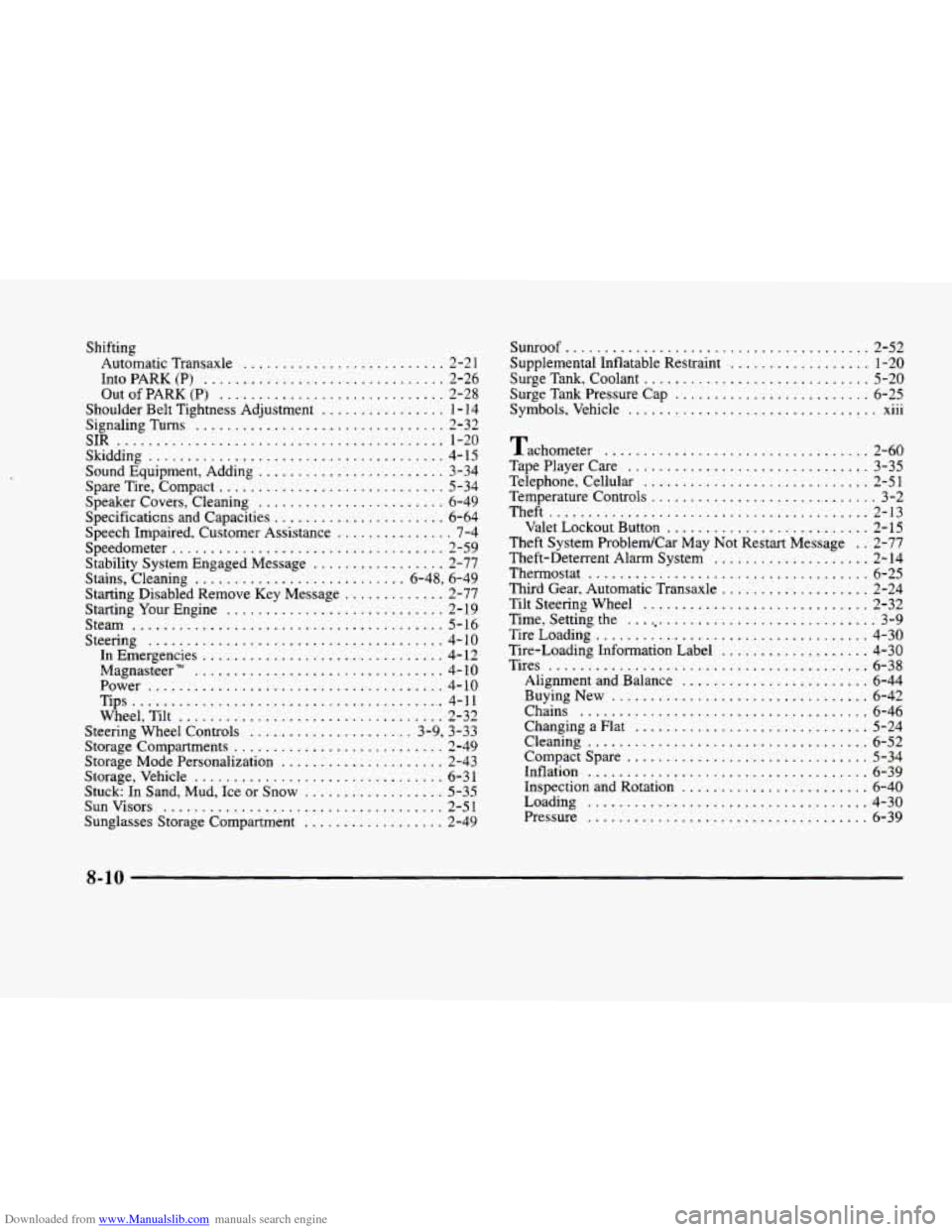
Downloaded from www.Manualslib.com manuals search engine Shifting Automatic Transaxle
.............
Into PARK (P) ..................
Out of PARK (P) ................
Shoulder Belt Tightness Adjustment ...
Signaling Turns ...................
SIR .............................
Skidding .........................
Sound Equipment, Adding ...........
Spare Tire, Compact ................
Speaker Covers, Cleaning ...........
Specificaticns and Capacities .........
Speech Impaired . Customer Assistance .
Stability System Engaged Message ....
Stains, Cleaning ...................
Starting Disabled Remove Key Message
Steam
...........................
In Emergencies ..................
Magnasteer TM ...................
Power .........................
Tips ...........................
Wheel, Tilt .....................
Steering Wheel Controls ............
Storage Compartments ..............
Storage Mode Personalization ........
Storage, Vehicle ...................
Stuck: In Sand, Mud, Ice or Snow .....
Sun Visors .......................
Sunglasses Storage Compartment .....
Speedometer ......................
Starting Your Engine ...............
Steering .........................
........
........
........
........
........
........
........
........
........
........
........
........
........
........
........
........
........
........
........
........
........
........
........
........
........
........
........
........
........
........
........
..... 2-21
..... 2-26
..... 2-28
..... 1-14
..... 2-32
..... 1-20
..... 4-15
..... 3-34
..... 5-34
..... 6-49
..... 6-64
...... 7-4
..... 2-59
..... 2-77
6.48. 6.49
..... 2-77
..... 2-19
..... 5-16
..... 4-10
..... 4-12
..... 4-10
..... 4-10
..... 4-11
..... 2-32
. 3.9. 3.33
..... 2-49
..... 2-43
..... 6-31
..... 5-35
..... 2-51
..... 2-49
Sunroof ....................................... 2- 52
Supplemental Inflatable Restraint .................. 1-20
Surge Tank, Coolant
............................. 5-20
Surge Tank Pressure Cap
......................... 6-25 ...
Symbols, Vehicle ................................ x111
Tachometer .................................. 2-60
TapePlayerCare
............................... 3-35
Telephone. Cellular
............................. 2-51
Temperature Controls
............................. 3-2
Theft ......................................... 2-13
Valet Lockout Button
.......................... 2-15
Theft System ProbledCar May Not Restart Message
. . 2-77
Theft-Deterrent Alarm System
.................... 2-14
Thermostat
.................................... 6-25
Third Gear, Automatic Transaxle
................... 2-24
Tilt Steering Wheel ............................. 2-32
Time, Setting the
................................. 3-9
Tire-Loading Information Label
................... 4-30
Alignment and Balance
........................ 6-44
BuyingNew
................................. 6-42
ChangingaFlat
.............................. 5-24
Tire
Loading
................................... 4-30
Tires
......................................... 6-38
Chains
..................................... 6-46
Cleaning
.................................... 6-52
Compactspare
............................... 5-34
Inflation
.................................... 6-39
Inspection and Rotation
........................ 6-40
Loading
.................................... 4-30
Pressure .................................... 6-39
8-10